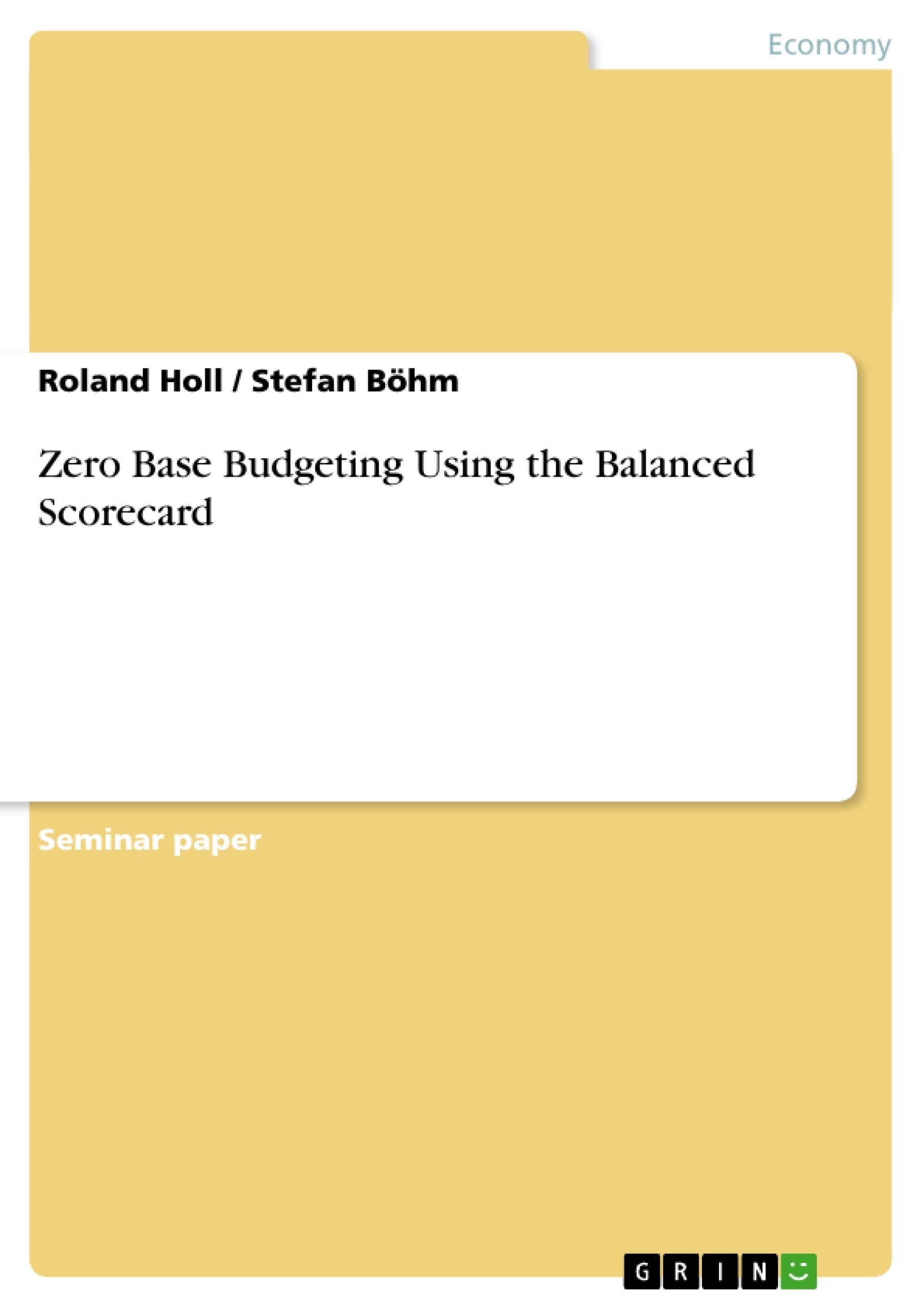The Planning Process itself is often defined differently across companies. One company might think of it as encompassing everything from strategy development to operational planning and quarterly forecasting, to management reporting and performance scorecards. For another company, it might be nothing more than developing departmental budgets once a year. The real purpose of planning (which companies can easily lose sight of) is to improve decision making. But not only decision making is of interest, there are other questions that need to be answered, for example how to handle overhead costs, create more efficiency and effectiveness in the company, through an optimized communication process. In this term paper, two completely different procedures, namely Zero base budgeting and the Balanced Scorecard are analyzed. The first two chapters deal with the attributes of BSC and ZBB. A typical course of actions for both procedures is illustrated and analyzed. Subsequently advantages and disadvantages of both operations are elaborated and a conclusion is drawn. Zero base budgeting is a bottom-up process, which means it starts at bottom and ends at the top(-management). The Balance Scorecard is top-down procedure, which is exact the opposite. At first view, therefore a combination of BSC and ZBB appears to be logical and perfect matching. The schedule of this construct, where ZBB is combined with the BSC, is performed in chapter four. Both ZBB and BSC feature lacks, because every single procedure of the two focuses on a specific assignment and neglects other important aspects. The question is, can the lacks of ZBB and BSC compensate each other, so that finally a procedure is generated, which unites the positive attributes of both processes. In order to analyze and judge the construct of “ZBB using the BSC”, different criteria are defined in chapter five, and the construct is being judge by these criteria, which represent attributes, a successful strategic, tactical and operational planning system should fulfil. In the end, a final conclusion is drawn, if it is possible to unite ZBB and BSC and to generate a procedure, whose benefits generally considered lies above its costs.
Inhaltsverzeichnis (Table of Contents)
- Introduction
- Zero Base Budgeting (8349)
- The Concept of Zero Base Budgeting
- Introduction
- Steps of Zero Base Budgeting
- Advantages of Zero Base Budgeting
- Disadvantages of Zero Base Budgeting
- Conclusion
- Brief overview of the BSC as a management system (15075)
- Reasons for developing the BSC
- Key concepts of the BSC
- Translate strategy into action
- Performance drivers and indicators
- Cause-and-Effect Relationships
- Double-loop-feedback and strategic learning
- The four perspectives
- The financial perspective
- The customer perspective
- The internal business perspective
- The learning and growth perspective
- Zero Base Budgeting using The Balanced Scorecard (8349)
- Construct of ZBB and BSC
- Implementation of BSC (Top-Down)
- Implementation of ZBB (Bottom-Up)
- Feedback and Conclusion
- Evaluation of ZBB using the BSC (15075)
- Criteria for an optimal planning process
- Analyzing the proposed concept with the criteria
- Controlling measures
- Alignment with organizations objectives
- Allocation of (limited) resources
- Feedback, Evaluation and Surveillance
- Strategic and operational decision-making-process
- Adopting environmental uncertainties and flexibility
- Performance and Motivation
- Communication and Participation
- Creativity
- Final remarks
Zielsetzung und Themenschwerpunkte (Objectives and Key Themes)
The term paper explores the potential of integrating Zero Base Budgeting (ZBB) and the Balanced Scorecard (BSC) to enhance organizational planning and decision-making processes. The paper aims to analyze the advantages and disadvantages of both methods individually and then investigate the potential benefits and drawbacks of combining them.
- Analyzing the core concepts and operational procedures of ZBB and BSC
- Examining the strengths and weaknesses of both individual methods
- Investigating the potential synergies and conflicts when ZBB and BSC are combined
- Developing criteria to evaluate the effectiveness of the proposed combined approach
- Assessing the potential of the ZBB-BSC combination to improve organizational planning and decision-making
Zusammenfassung der Kapitel (Chapter Summaries)
- Introduction: This chapter sets the stage for the term paper by introducing the concept of planning and its importance for organizational success. It emphasizes the need for effective decision-making and highlights the contrasting approaches of ZBB and BSC.
- Zero Base Budgeting: This chapter delves into the concept of ZBB, outlining its fundamental principles, steps involved in its implementation, and its advantages and disadvantages.
- Brief overview of the BSC as a management system: This chapter introduces the Balanced Scorecard, detailing its origins, key concepts, and its four perspectives: financial, customer, internal business, and learning and growth.
- Zero Base Budgeting using The Balanced Scorecard: This chapter explores the concept of combining ZBB and BSC, discussing the potential benefits and challenges of integrating these two approaches.
- Evaluation of ZBB using the BSC: This chapter focuses on analyzing the proposed combination of ZBB and BSC based on specific criteria that are essential for an effective planning system. The criteria include elements such as controlling measures, alignment with organizational objectives, resource allocation, feedback and evaluation, decision-making processes, flexibility, performance and motivation, communication, and creativity.
Schlüsselwörter (Keywords)
Zero Base Budgeting, Balanced Scorecard, Planning, Decision-making, Strategic Management, Performance Measurement, Resource Allocation, Organizational Effectiveness, Integration, Synergy, Criteria, Evaluation, Implementation, Top-Down, Bottom-Up.
- Citar trabajo
- Roland Holl (Autor), Stefan Böhm (Autor), 2005, Zero Base Budgeting Using the Balanced Scorecard, Múnich, GRIN Verlag, https://www.grin.com/document/40666



